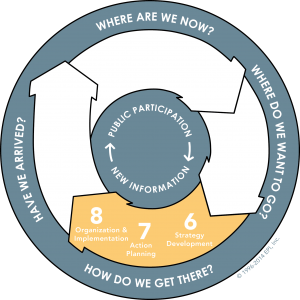We were approached by the Council for the Advancement of Native Development Officers (Cando) to write a quarterly article on the strategic planning process for their newsletter – ‘N-Side’. Cando is a great organization that provides support and capacity building for Economic Development Officers in First Nations communities.
Cando has now published 4 of the 5 articles in the series, and we thought we’d republish the articles here on our blog as they come out (though, admittedly, they are a bit long for a blog post!). The articles follow the 10 step strategic planning process that we use in all our work, and each article will highlight a few of the planning steps. We are happy to share this information and hope that it is useful for your planning processes. If you are going to use it in toolkits, guides, or other materials please give us credit.
The following article was published in the September 2013 Issue of Cando N-Side News.

By William Trousdale and Colleen Hamilton, EcoPlan International
The planning process we are describing follows a ten-step process, structured around four Big Questions (see image). In this article, we’ll be working through the

third Big Question – HOW DO WE GET THERE? – in which we’ll be developing and evaluating action ideas for economic development that are grounded in the realities of the community.
The long list
The first step is to generate a ‘long list’ of potential action ideas. This can be a fun stage and an opportunity to involve the community, staff and other stakeholders. It is likely that community members have great ideas for economic development actions, but no one has ever asked them! A few ideas for generating actions are:
- Use the economic situation assessment from earlier steps to help everyone understand the realities of the community
- Present the Objectives from step 5 of the planning process, and use this as a springboard action brainstorming
- Provide a map of the community’s lands and ask people to draw or write economic activities on the map
- Conduct separate sessions with staff and community to see if similar actions come up
- Consider taking a field trip to another community to see what they have done and talk to their planners
Tip: Getting ideas from everyone
Not everyone is comfortable speaking up in group discussions, but some people thrive on it. Others prefer to quietly consider a question and write down their answer. Some people prefer to draw!
Think about this as you design your stakeholder engagement. You’ll get more responses from stakeholders if you accommodate a variety of participation styles. Some methods include note cards, group discussions, break-out groups, take-home surveys, or even drawing activities.
Once you have a long list of actions, you can begin organizing the actions and cleaning it up a bit. Are there any similar ones that can be combined? Are some of the actions actually steps within another action? Are any of the actions completely unfeasible or just plain silly? Are any of them ‘quickstarts’ that could be done quickly and easily and don’t require further evaluation?
The short list
Wouldn’t it be great if you could implement all the action ideas on the long list? Realistically there will be constraints in terms of time, money or capacity, and so you have to prioritize the actions that best meet your objectives.
A great way to do this is by using a consequence table (see example below). A consequence table helps you to compare the different actions, by examine how well each action satisfies each community objective. It’s a great way to get all the facts out on the table, so that decision-makers can make informed decisions.

In this example, the Band-owned forestry company would have the biggest impact on the community’s objectives. Make sure you take the real constraints of the community into account when choosing actions.
Implementation: Make the actions a reality
We all know that many plans end up Setting On Shelves (we like to call it SOS syndrome). To prevent this, it’s important to develop an implementation plan that outlines:
- What actions will happen in what order
- What sub-tasks have to happen to achieve each action
- Who will do which task, and when
- What funding needs to be applied for, and when
Conclusion
In the next installment of this series we’ll be talking about developing a monitoring and evaluation strategy to make sure that actions are having the desired effect, and can be updated over time as needed.
William Trousdale is the lead author of: “Promoting Local Economic Development through Strategic Planning” by UN-HABITAT and EcoPlan International (contact him for a copy). He can be reached at william@ecoplan.ca. Colleen Hamilton is a planning analyst at EcoPlan. She can be reached at colleen@ecoplan.ca
